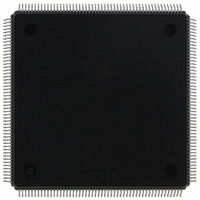MCF5407AI220 Freescale Semiconductor, MCF5407AI220 Datasheet - Page 121

MCF5407AI220
Manufacturer Part Number
MCF5407AI220
Description
IC MPU 32B 220MHZ COLDF 208-FQFP
Manufacturer
Freescale Semiconductor
Series
MCF540xr
Specifications of MCF5407AI220
Core Processor
Coldfire V4
Core Size
32-Bit
Speed
220MHz
Connectivity
EBI/EMI, I²C, UART/USART
Peripherals
DMA, WDT
Number Of I /o
16
Program Memory Type
ROMless
Ram Size
4K x 8
Voltage - Supply (vcc/vdd)
1.65 V ~ 3.6 V
Oscillator Type
External
Operating Temperature
0°C ~ 70°C
Package / Case
208-FQFP
Maximum Clock Frequency
220 MHz
Operating Supply Voltage
1.8 V, 3.3 V
Maximum Operating Temperature
+ 105 C
Mounting Style
SMD/SMT
Minimum Operating Temperature
0 C
Program Memory Size
24KB
Cpu Speed
220MHz
Embedded Interface Type
I2C, UART
Digital Ic Case Style
FQFP
No. Of Pins
208
Supply Voltage Range
3.3V
Rohs Compliant
Yes
For Use With
M5407C3 - KIT EVAL FOR MCF5407 W/ETHERNET
Lead Free Status / RoHS Status
Lead free / RoHS Compliant
Eeprom Size
-
Program Memory Size
-
Data Converters
-
Lead Free Status / Rohs Status
Lead free / RoHS Compliant
Available stocks
Company
Part Number
Manufacturer
Quantity
Price
Company:
Part Number:
MCF5407AI220
Manufacturer:
freescaie
Quantity:
6
Company:
Part Number:
MCF5407AI220
Manufacturer:
Freescale Semiconductor
Quantity:
135
Company:
Part Number:
MCF5407AI220
Manufacturer:
FREESCALE
Quantity:
1 831
Company:
Part Number:
MCF5407AI220
Manufacturer:
Freescale Semiconductor
Quantity:
10 000
- Current page: 121 of 546
- Download datasheet (7Mb)
These registers are described as follows:
3.1.0.2 General Operation
The MAC unit supports the ColdFire integer multiply instructions (MULS and MULU) and
provides additional functionality for multiply-accumulate operations. The added MAC
instructions to the ColdFire ISA provide for the multiplication of two numbers, followed
by the addition or subtraction of this number to or from the value contained in the
accumulator. The product may be optionally shifted left or right one bit before the addition
or subtraction takes place. Hardware support for saturation arithmetic may be enabled to
minimize software overhead when dealing with potential overflow conditions using signed
or unsigned operands.
These MAC operations treat the operands as one of the following formats:
To maintain compactness, the MAC module is optimized for 16-bit multiplications. Two
16-bit operands produce a 32-bit product. Longword operations are performed by reusing
the 16-bit multiplier array at the expense of a small amount of extra control logic. Again,
the product of two 32-bit operands is a 32-bit result. For longword integer operations, only
the least significant 32 bits of the product are calculated. For fractional operations, the
entire 63-bit product is calculated and then either truncated or rounded to a 32-bit result
using the round-to-nearest (even) method.
Because the multiplier array is implemented in a 3-stage pipeline, MAC instructions can
have an effective issue rate of one clock for word operations, three for longword integer
operations, and four for 32-bit fractional operations. Arithmetic operations use
register-based input operands, and summed values are stored internally in the accumulator.
Thus, an additional MOVE instruction is necessary to store data in a general-purpose
register. MAC instructions can choose the upper or lower word of a register as the input,
which helps filtering operations in which one data register is loaded with input data and
another is loaded with coefficient data. Two 16-bit MAC operations can be performed
without fetching additional operands between instructions by alternating the word choice
during the calculations.
• Accumulator (ACC)—This 32-bit, read/write, general-purpose register is used to
• Mask register (MASK)—This 16-bit general-purpose register provides an optional
• MAC status register (MACSR)—This 8-bit register defines configuration of the
• Signed integers
• Unsigned integers
• Signed, fixed-point, fractional numbers
accumulate the results of MAC operations.
address mask for MAC instructions that fetch operands from memory. It is useful in
the implementation of circular queues in operand memory.
MAC unit and contains indicator flags affected by MAC instructions. Unless noted
otherwise, the setting of MACSR indicator flags is based on the final result, that is,
the result of the final operation involving the product and accumulator.
Chapter 3. Hardware Multiply/Accumulate (MAC) Unit
Overview
3-3
Related parts for MCF5407AI220
Image
Part Number
Description
Manufacturer
Datasheet
Request
R
Part Number:
Description:
Mcf5407 Coldfire Integrated Microprocessor User
Manufacturer:
Freescale Semiconductor, Inc
Datasheet:
Part Number:
Description:
Manufacturer:
Freescale Semiconductor, Inc
Datasheet:
Part Number:
Description:
Manufacturer:
Freescale Semiconductor, Inc
Datasheet:
Part Number:
Description:
Manufacturer:
Freescale Semiconductor, Inc
Datasheet:
Part Number:
Description:
Manufacturer:
Freescale Semiconductor, Inc
Datasheet:
Part Number:
Description:
Manufacturer:
Freescale Semiconductor, Inc
Datasheet:
Part Number:
Description:
Manufacturer:
Freescale Semiconductor, Inc
Datasheet:
Part Number:
Description:
Manufacturer:
Freescale Semiconductor, Inc
Datasheet:
Part Number:
Description:
Manufacturer:
Freescale Semiconductor, Inc
Datasheet:
Part Number:
Description:
Manufacturer:
Freescale Semiconductor, Inc
Datasheet:
Part Number:
Description:
Manufacturer:
Freescale Semiconductor, Inc
Datasheet:
Part Number:
Description:
Manufacturer:
Freescale Semiconductor, Inc
Datasheet:
Part Number:
Description:
Manufacturer:
Freescale Semiconductor, Inc
Datasheet:
Part Number:
Description:
Manufacturer:
Freescale Semiconductor, Inc
Datasheet:
Part Number:
Description:
Manufacturer:
Freescale Semiconductor, Inc
Datasheet:











